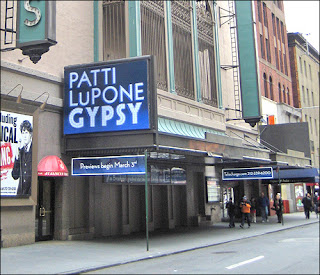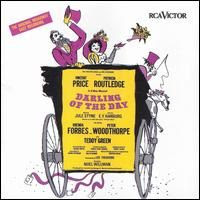It took me years to warm up to Sunday in the Park with George. There I admit it; in fact the first time I saw the taping of the original Broadway production, aside from Bernadette Peters and the end of the first act, I was bored. The jaunty atonal score was initially unmemorable; leaving little to no impression on me. Plus, I have never been a big fan of Mandy Patinkin, so that didn’t help any.
However, the more I matured, the more I kept pushing myself back to the score; I always felt like I was missing something important about it; and was intrigued. It took years of listening, and several attempts at viewing the production; reading about it plus reading the libretto that started the thawing process. Not that every musical should have that laborious nature (indeed, while I have come to respect and admire Passion, I will never love it).
Anyway, the clincher was in 2004 when I was asked to work on my college’s production as dramaturge. I immersed myself in the information around the show: I read all I could on Sondheim and Sunday from varying texts and sources. Reviews, biographies, intricate analyses, you name it. I also auditioned for the show, merely for fun, since I knew that as an outsider who wasn’t a major in the theatre department, I would never be seriously considered for any roles. My audition went very well. I sang the patter section of “It Would Have Been Wonderful” and the last A section of “Love Can’t Happen” (in the show key, to toot my own horn) and did a Nicky Silver monologue. It went much better than I (and I think they) expected. I got a callback. Well, that didn’t go very well. (The confidence I had at the initial audition was thoroughly depleted when met by the condescending glares of the other actors). And I wasn’t cast. So we set about working on the show; I was rarely utilized by the cast and crew for questions throughout the rehearsal period, but was ready to be a source if necessary.
Then I got put into the show (the person playing “Man with Bicycle” and “Man on Shore” opted not to accept his part); mostly to add my voice to the choral numbers, an extra person to hit the high G’s in “Sunday.” However, getting involved in table work and talking about the productions; and even seeing things in the Lincoln Center TOFT archive (which included the original Playwrights Horizons workshop), my eyes were opened to the artistic genius at work. Anyway, I’ve experienced this feeling of protectiveness whenever I’ve been involved with a show where I develop a sort of unconditional love for the work; even if it be a red-headed step child of the theatre.
I came to love Sunday in the Park with George.
And I saw it live as an audience member for the first time last night at the first preview of the Broadway revival playing at Studio 54. It’s an import of the British production that played the Menier Chocolate Factory in 2006 and contains the Olivier-winning stars of that production; Daniel Evans and Jenna Russell (the latter making her Broadway debut). Supporting the two superlative stars are the superb Broadway veterans Michael Cumpsty, Jessica Molaskey, Anne L. Nathan, Ed Dixon and the delightful Mary Beth Peil.
The production affected me in many ways. I was mesmerized by the animation of the scenic design which cleverly altered itself to show a flash of a figure of the painting here and there or even the subtle encroachment of autumn during “Beautiful.” (They even used the animated projections for the multiple George sequence in “Putting it Together”). The twilight effect of the streetlamps on La Grand Jatte 1984 during “Lesson #8 was a sheer marvel of subtlety and of scenography complementing the onstage action.
Evans is particularly stunning as George. Though Mandy has his teeth firmly embedded into the role (which was also aided by the original Broadway cast recording being the only album of the score for 22 years), for the first time I felt I understood George. I saw an artist so dedicated to his work and so close to a breakthrough that he shuns the world and eventually loses the great love of his life as a result. His George wasn’t a cryptic brooding mess of nerves; there was a heart to Evans’ George that took on new and refreshing dynamics, especially driving home “Finishing the Hat” (which received the Peter Filichia applause: the audience response was huge; it started to dissipate only to re-emerge louder and more pronounced than before). The song “Beautiful” is one of the most quietly poignant moments Mr. Sondheim has created; you have juxtaposing opinions of perspective and change between George and his somewhat senile mother. George finds such promise in change; “Pretty is what changes…” while nostalgia and a dislike of change gets the best of her “How I long for the old view.” It’s a moment of remarkable depth; especially hearing George find beauty in all that he sees, whether it be old or new, and his commitment to capturing it as an artist. Russell founds ways of both reinventing Dot and yet at times, coming so close to reminding me of Bernadette. She’s beautiful, she gets the laughs and while she may not be as warm as the famed originator of the part, she does manage to give Dot a loving heart. She scored especially well as Marie in the second act with a devastating “Children and Art.”
What was most surprising was the amount of polish since it was their first performance in front of an audience. The lighting cues are many (the tech rehearsal must have been hell) and so much of the production revolves around the lighting and projections for its full effect. While there could be a little tightening in spots (particularly “Putting it Together” which has always been too long), they have a rich foundation on which they will continue to grow throughout the run.
Speaking of quibbles… the pit. Five pieces, are you kidding me? Why don’t you just get Dick Van Dyke to reprise his one-man band Bert from Mary Poppins and save even more money. The loss of the French horn is the most mournful in the instrumentation; the sax substitute is lackluster. This is not Sunday in the Park with Kenny G. Others had quibbled with the use of British accents in the first act, but I was strangely okay with that; which also got me wondering how well the show would translate to French… Another weak spot: Alexander Gemignani is rather annoying onstage. Didn’t love him in Sweeney Todd and didn’t care for him here as the Boatman.
The show has always been plagued by its second act which is necessary to the authors’ intent, but doesn’t live up to the magic of the first (one review of the original production said act one was the best new musical in town; act two the worst). I have never seen the problematic second act run as smoothly and enjoyably as it did last night. Moment to moment, I was continually impressed; particularly the final 20-30 minutes; rich are the songs “Children and Art” (the lyrics in this song alone are enough to warrant its Pulitzer Prize win, followed by “Lesson #8” and the long-awaited musical release in “Move On” (which no doubt would have brought the house in on itself had it not been directed to move directly into dialogue and leave us without the opportunity to applaud; I’ll be quicker next time). It was ethereal.
The moment that has haunted me through the day the most and will likely continue to do so for a long time was the final moment of the show. There is the reprise of the “Sunday” anthem with 1984 George connecting with Dot and the characters of the painting. In the moment following the exit of the characters from the stage, the projections have reversed themselves and gone back to a pure white stage.
George reads: “White. A blank page or canvas. His favorite. So many possibilities…”
My breath was drawn and my heart exploded with emotion when he turned upstage and made his breakthrough; gasping with rapture and openness at the white canvas that lay ahead for him as an artist. The words that I have just written can’t even begin to explain just how stunning this final flourish was as the lights went out. All I know is that it will stay with me always.
The ovation was extraordinary. As the house lights came up, the audience only increased its roar of approval; and it was clear no one was going anywhere until the cast came out one more time, which they did. Both Evans and Russell were visibly overwhelmed by the reception. I love impromptu moments like that.
Not everyone I was with shared my enthusiastic view, but Sondheim interpretations generally tend to polarize than unite. It’s the nature of the beast and that’s all right with me. It was just enough to share the night with a slew of classy friends and acquaintances.
I’m already going back. It can’t be soon enough for me.
Side note: Miles said observed that Sunday is the MILF of musicals; it gets better with age. Not the classiest observation I’ve heard, but he’s actually not far from the truth (though in his favor, he also referred to it as a fine wine, but I found this reference more amusing). Sweeney Todd is the masterpiece, Follies the cult favorite, and Pacific Overtures the most intriguing; Sunday in the Park With George is probably Sondheim’s most fascinating score.
Second side note: I apparently bear a striking resemblance to Georges Seurat (at least the onstage version) as was pointed out to me by two strangers in the lobby at intermission.


